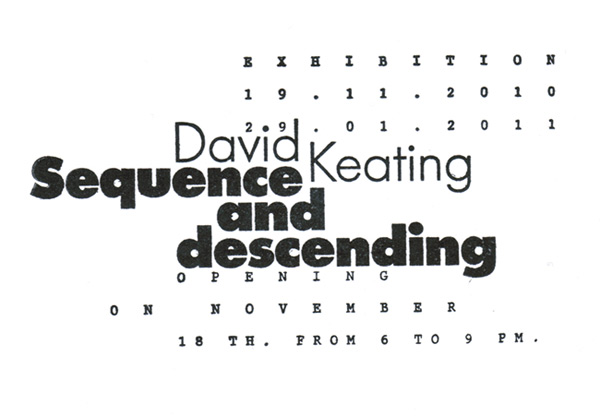David Keating. Sequence and descending
November 19 – January 29, 2011
Pfingstweidstrasse 23 / Welti-Furrer Areal, 8005 Zürich
Opening reception: Thursday November 18, 6 – 9 pm
Grey office carpets are the starting point for a series of new sculptures by the Australian-born, Berlin-based artist David Keating. Cut, hung on steel armatures and stiffened with glue and paint, the previously downtrodden material is invested with energy and attitude, forming abstract figures full of anthropomorphic prowess.
Keating’s art sets up a number of relationships, testing, as he puts it, ‘degrees of interdependence.’ His sculptures explore the relationship between medium and form, interfering with the natural behaviour of materials whose weight and character the viewer remains heavily aware of. Standing assertively they exert a theatricality that creates a relationship between the viewer’s own body, the works, and the space. Yet this dynamic is secondary to the drama played out within the sculpture itself: the carpet’s submission to and dependence on the thin metal rod that supports it, its capacious caress and the range of emotions that its deportment suggests. By turns the works seem flamboyant and shy, violent and vulnerable — always intimately involved. Keating’s titles such as ‘I like for you to be still’ further invite imaginative responses to his pieces, freighting them with menace and ambivalence and hinting at the possibility of an over-controlling relationship between artist and artwork.
The carpet sculptures probe abstraction’s memory of the figure and of earlier abstractions. Bodies devoid of interiors, they call to mind the disfigurements of Modernism — the hollowed, twisting bodies of Henry Moore, for instance, or the jagged unravellings wrought by Cubism — associations which the grungy appearance of their synthetic material challenges. Whilst their forms evoke modernist abstraction yet subvert its codes, their material and self-conscious objecthood recall Minimalism, resisting Michael Fried’s doctrine on the need to segregate mediums. Keating’s carpet works are simultaneously both sculpture and painting. They are three-dimensional forms that are nonetheless all surface.
Other works by Keating likewise muddy the distinction between spatial dimensions. Rope sculptures are drawings framed in space, their painted lines looping lyrically; part capitulating to gravity, part thwarting its demands. Hung from thin steel armatures that are either affixed to the wall or bent into a freestanding configuration, the means of support gets as much attention as the rope itself. Likewise in new works featuring chicken wire, the material conventionally used to make the internal structure of sculptures becomes a prominent component, circling roughly painted MDF boards. In these, the traditional composition of sculptures turned inside out, whilst the intimated figure is reduced to the barest of elements: to a slab of wood held in a mortal coil made of malleable mesh.





























